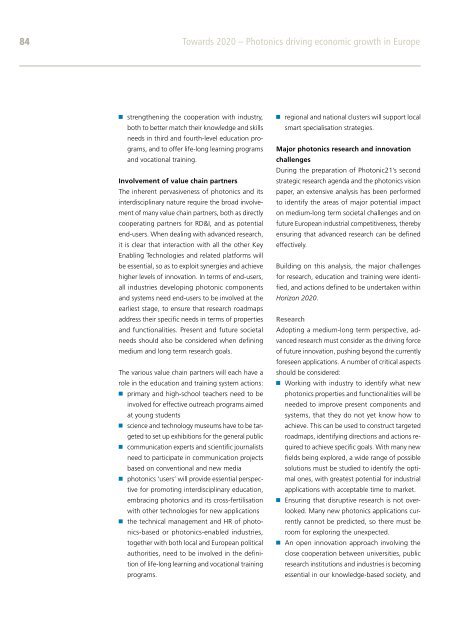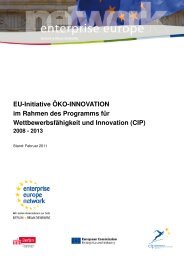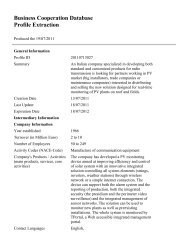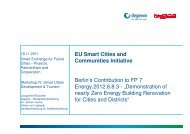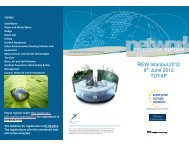Photonics Driving Economic Growth in Europe - Photonics21
Photonics Driving Economic Growth in Europe - Photonics21
Photonics Driving Economic Growth in Europe - Photonics21
Create successful ePaper yourself
Turn your PDF publications into a flip-book with our unique Google optimized e-Paper software.
84 Towards 2020 – <strong>Photonics</strong> driv<strong>in</strong>g economic growth <strong>in</strong> <strong>Europe</strong><br />
n strengthen<strong>in</strong>g the cooperation with <strong>in</strong>dustry,<br />
both to better match their knowledge and skills<br />
needs <strong>in</strong> third and fourth-level education pro-<br />
grams, and to offer life-long learn<strong>in</strong>g programs<br />
and vocational tra<strong>in</strong><strong>in</strong>g.<br />
Involvement of value cha<strong>in</strong> partners<br />
The <strong>in</strong>herent pervasiveness of photonics and its<br />
<strong>in</strong>terdiscipl<strong>in</strong>ary nature require the broad <strong>in</strong>volve-<br />
ment of many value cha<strong>in</strong> partners, both as directly<br />
cooperat<strong>in</strong>g partners for RD&I, and as potential<br />
end-users. When deal<strong>in</strong>g with advanced research,<br />
it is clear that <strong>in</strong>teraction with all the other Key<br />
Enabl<strong>in</strong>g Technologies and related platforms will<br />
be essential, so as to exploit synergies and achieve<br />
higher levels of <strong>in</strong>novation. In terms of end-users,<br />
all <strong>in</strong>dustries develop<strong>in</strong>g photonic components<br />
and systems need end-users to be <strong>in</strong>volved at the<br />
earliest stage, to ensure that research roadmaps<br />
address their specific needs <strong>in</strong> terms of properties<br />
and functionalities. Present and future societal<br />
needs should also be considered when def<strong>in</strong><strong>in</strong>g<br />
medium and long term research goals.<br />
The various value cha<strong>in</strong> partners will each have a<br />
role <strong>in</strong> the education and tra<strong>in</strong><strong>in</strong>g system actions:<br />
n primary and high-school teachers need to be<br />
<strong>in</strong>volved for effective outreach programs aimed<br />
at young students<br />
n science and technology museums have to be targeted<br />
to set up exhibitions for the general public<br />
n communication experts and scientific journalists<br />
need to participate <strong>in</strong> communication projects<br />
based on conventional and new media<br />
n photonics ‘users’ will provide essential perspective<br />
for promot<strong>in</strong>g <strong>in</strong>terdiscipl<strong>in</strong>ary education,<br />
embrac<strong>in</strong>g photonics and its cross-fertilisation<br />
with other technologies for new applications<br />
n the technical management and HR of photo -<br />
nics-based or photonics-enabled <strong>in</strong>dustries,<br />
together with both local and <strong>Europe</strong>an political<br />
authorities, need to be <strong>in</strong>volved <strong>in</strong> the def<strong>in</strong>ition<br />
of life-long learn<strong>in</strong>g and vocational tra<strong>in</strong><strong>in</strong>g<br />
programs.<br />
n regional and national clusters will support local<br />
smart specialisation strategies.<br />
Major photonics research and <strong>in</strong>novation<br />
challenges<br />
Dur<strong>in</strong>g the preparation of Photonic21’s second<br />
strategic research agenda and the photonics vision<br />
paper, an extensive analysis has been performed<br />
to identify the areas of major potential impact<br />
on medium-long term societal challenges and on<br />
future <strong>Europe</strong>an <strong>in</strong>dustrial competitiveness, thereby<br />
ensur<strong>in</strong>g that advanced research can be def<strong>in</strong>ed<br />
effectively.<br />
Build<strong>in</strong>g on this analysis, the major challenges<br />
for research, education and tra<strong>in</strong><strong>in</strong>g were identified,<br />
and actions def<strong>in</strong>ed to be undertaken with<strong>in</strong><br />
Horizon 2020.<br />
Research<br />
Adopt<strong>in</strong>g a medium-long term perspective, ad-<br />
vanced research must consider as the driv<strong>in</strong>g force<br />
of future <strong>in</strong>novation, push<strong>in</strong>g beyond the currently<br />
foreseen applications. A number of critical aspects<br />
should be considered:<br />
n Work<strong>in</strong>g with <strong>in</strong>dustry to identify what new<br />
photonics properties and functionalities will be<br />
needed to improve present components and<br />
systems, that they do not yet know how to<br />
achieve. This can be used to construct targeted<br />
roadmaps, identify<strong>in</strong>g directions and actions re-<br />
quired to achieve specific goals. With many new<br />
fields be<strong>in</strong>g explored, a wide range of possible<br />
solutions must be studied to identify the optimal<br />
ones, with greatest potential for <strong>in</strong>dustrial<br />
applications with acceptable time to market.<br />
n Ensur<strong>in</strong>g that disruptive research is not overlooked.<br />
Many new photonics applications currently<br />
cannot be predicted, so there must be<br />
room for explor<strong>in</strong>g the unexpected.<br />
n An open <strong>in</strong>novation approach <strong>in</strong>volv<strong>in</strong>g the<br />
close cooperation between universities, public<br />
research <strong>in</strong>stitutions and <strong>in</strong>dustries is becom<strong>in</strong>g<br />
essential <strong>in</strong> our knowledge-based society, and


